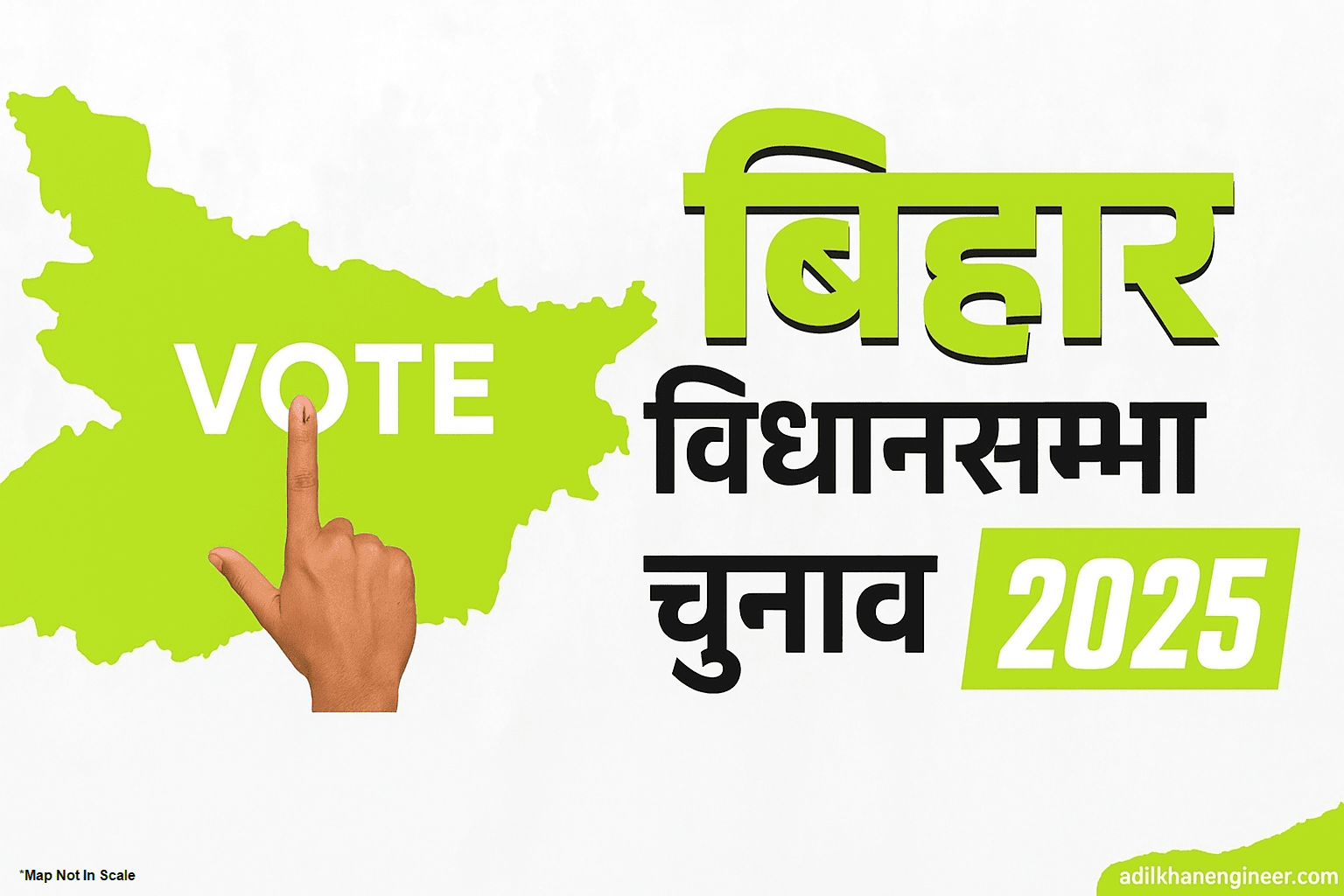The Bihar Assembly Elections 2025 is a crucial contest that will determine the state’s political direction. This election is not only a direct confrontation between the National Democratic Alliance (NDA) and the INDIA Bloc (Grand Alliance/Mahagathbandhan), but the presence of a third faction, like ‘Jan Suraaj’ led by Prashant Kishor (PK), has made this election triangular and unpredictable. At the same time, Asaduddin Owaisi’s AIMIM party is also looking to make a big play, forming a Third Front to give a quadrangular shape to this Bihar election.
The ruling NDA alliance, under the leadership of Chief Minister Nitish Kumar, is fighting to retain power, while the Mahagathbandhan, led by Tejashwi Yadav, is hoping for a strong comeback. The election dates have been announced: voting will take place in the first phase on November 6 and the second phase on November 11, 2025. Results will be declared on November 14. This election is being fought on the issues of caste equations, youth leadership, and coalition stability. The BJP is making every effort to give the election a Hindu-Muslim colour.
Initial Phase of the Election Atmosphere
The election fever has intensified, and several high-profile campaigns are underway in the state, heating up the atmosphere:

Rahul Gandhi: Foot Marches (Padayatras) and Joint Rallies
As 2024 arrived, Congress leader Rahul Gandhi, who is part of the Mahagathbandhan (INDIA Bloc), started registering his presence among the voters through continuous rallies, foot marches, and public meetings. He consistently targeted the Central and State NDA governments primarily on the issues of farmers, unemployment, poverty, and vote-theft.
Rahul Gandhi’s relentless visits to Bihar sparked a new discussion in the market, which worked to boost the morale of Congress workers. Furthermore, he successfully attempted to unite the opposition parties by holding joint rallies with the leaders of the ‘Mahagathbandhan’ and focused on strengthening them, aiming to present a strong challenge to the ruling NDA in both the center and the state.
As a result, in one event, Tejashwi Yadav declared Rahul Gandhi as the Prime Ministerial face of the Mahagathbandhan, making it clear that the opposition leader, Shri Rahul Gandhi, has now completely become the leader of the Grand Alliance as well.
The electoral impact of Rahul Gandhi’s foot marches in Bihar (such as the part of ‘Bharat Jodo Nyay Yatra’ or ‘Voter Adhikar Yatra’) can be seen in several dimensions, the main objective of which was to strengthen the Congress party and unite the Mahagathbandhan.
Here is a detailed analysis of this:
Boost to Congress Workers’ Enthusiasm and Party Revival:
The long foot marches injected new enthusiasm into the local Congress workers and cadre who had been sluggish for years. This re-energized the party organization at the grassroots level. A national leader like Rahul Gandhi directly engaging with the public was an attempt to bring the Congress back into the main political contest in Bihar, where it had long worked under the shadow of regional parties.
Establishing Key Political Issues:
Rahul Gandhi repeatedly raised the issue of Caste Census in his travels. He argued that ‘justice’ could only be delivered to OBCs, Dalits, and Tribals after ascertaining their true proportion in the country’s population. This has been a central topic in Bihar politics and a major effort to court the core vote bank of the Mahagathbandhan (OBC and EBC).
During the ‘Voter Adhikar Yatra’, Rahul Gandhi raised the alleged issue of irregularities in the voter list (Special Intensive Revision – SIR) and accused the NDA of ‘vote-theft’. This was an aggressive electoral narrative aimed at uniting the opposition supporters by questioning the Election Commission’s impartiality. The ‘Election Commission’ could not give a direct answer to any of Rahul Gandhi’s questions, and the matter reached the Supreme Court.
By highlighting unemployment among the youth and inflation among the common populace, he directly attacked both the Central and State (then NDA) governments, which was an attempt to connect with the youth and the poor sections.
Impact on Mahagathbandhan (INDIA Bloc) Unity:
The participation of Tejashwi Yadav and other Mahagathbandhan leaders in Rahul Gandhi’s tours (especially in the ‘Voter Adhikar Yatra’) sent a message of strong opposition unity to the public.
Some political analysts believed that Rahul Gandhi’s foot march gave the Congress more recognition as a prominent ally in Bihar’s politics, creating a possibility of RJD being ‘overshadowed’ to some extent. However, the joint presence of both leaders demonstrated the strength of the alliance.
Courting Regional and Caste Equations:
The route of the ‘Bharat Jodo Nyay Yatra’ passed through the Seemanchal region, which has a high influence of minority voters. This was a strategic effort for both Congress and the Mahagathbandhan to solidify this important vote bank. In some of the yatras, he also focused on regions like Mithila and Champaran, which have a higher population of Brahmins and other forward castes, aiming to penetrate this vote bank traditionally considered a BJP stronghold.
Overall Impact on the Election Atmosphere:
Rahul Gandhi’s foot marches drew huge crowds, garnering extensive media coverage and intensifying the electoral atmosphere in Bihar. This forced the ruling party (NDA) to reconsider its strategies, as evidenced by the reactions of BJP leaders.
NDA leaders tried to dismiss Rahul Gandhi’s yatras as ‘directionless’ and ‘aimless,’ but simultaneously, they also ramped up their public outreach activities. This yatra served to increase polarization in Bihar’s politics.
In summary, even if the immediate electoral impact of Rahul Gandhi’s Bihar foot march is not clearly visible in terms of seats, it did the important work of boosting the morale of the Congress, providing a shared platform to the Mahagathbandhan, and bringing key issues like caste census, unemployment, and ‘vote-theft’ to the centre of Bihar’s politics.
Modi’s Campaign and Attack on ‘Jungle Raj’:
In the initial electoral atmosphere, the charismatic leadership of Prime Minister Narendra Modi and the agenda of national security and development are at the core of the National Democratic Alliance (NDA)’s strategy. Modi is the biggest strength of the NDA alliance. The NDA alliance is primarily focusing on two main points:
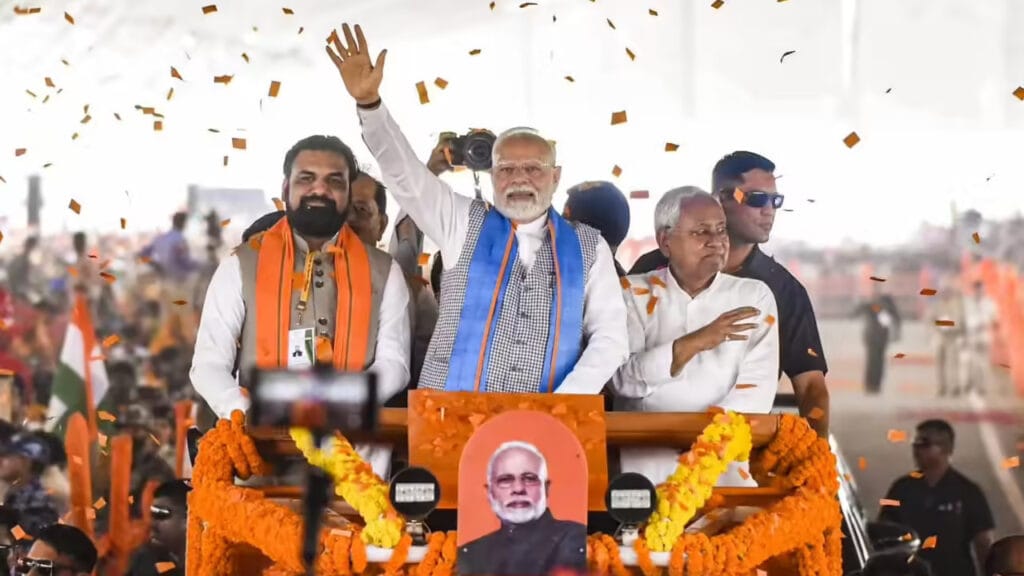
Direct Attack on ‘Jungle Raj’:
Prime Minister Modi and other top BJP leaders have attempted to caution voters by referring to the previous rule of the opposition (especially the Rashtriya Janata Dal – RJD) as ‘Jungle Raj’. Their aim is to remind the youth and first-time voters of the anarchy, corruption, and poor law and order situation of the old era, thereby keeping them away from the Mahagathbandhan. This attack is specifically being made to strengthen the image of good governance of Nitish Kumar (who is the Chief Minister of the current alliance), in order to capitalize on his administrative efficiency and experience.
Benefits of Central Schemes and ‘Double Engine’ Government:
Modi has emphasized the importance of a ‘Double Engine’ (the same alliance government at the Centre and in the State) by mentioning the welfare schemes of the Central Government (such as Ayushman Bharat, PM-Kisan Samman Nidhi, free rations). He argues that only a “Double Engine” government can accelerate Bihar’s development, while the opposition will hinder the state’s progress.
The ‘Trump Card’ to Woo Women:
A special focus in the NDA’s strategy is on wooing women, who are considered the biggest supporters of Nitish Kumar’s good governance.
Benefit of the ₹10,000 Financial Assistance Scheme:
The special financial assistance scheme of ₹10,000 being given to women in Bihar after higher education (upon passing graduation) is a big trump card for the NDA. This scheme is creating immense goodwill towards the alliance by delivering direct financial assistance to young, especially female, voters. Observing the success of similar schemes in states like Madhya Pradesh and Maharashtra, the NDA is heavily promoting this scheme to court a large section of the female electorate in Bihar.
NDA’s Challenges and Negative Aspects
While the NDA alliance relies on the charisma of Prime Minister Modi and the good governance of Nitish Kumar, there are some internal and external challenges that could benefit the Mahagathbandhan.
Lack of Internal Coordination and Seat Sharing
Scattered Leadership:
The NDA includes several regional allies, as is the case every time—BJP, JD(U), LJP (R), RLM, and HAM. Keeping such a large number of constituent parties united on one platform and ensuring seat-sharing coordination among them is a major challenge. Leaders like Chirag Paswan and Upendra Kushwaha have their own ambitions and demands, which created resentment among grassroots workers regarding seats, although the issue was resolved in time. Some political observers believe that the BJP has other ways to convince the constituent parties of the NDA alliance, such as the ED, CBI, etc.
Both Nitish Babu and Jitan Ram Manjhi were upset over the seat distribution. According to some political analysts and media reports, Nitish Kumar has been virtually placed under house arrest by the BJP, not being allowed to meet anyone. The BJP, which played the role of the younger brother in the last election, is contesting on an equal number of seats as the JD(U) this time, a fact that has deeply displeased Nitish Babu. Furthermore, the previous 2020 Assembly election was fought on the face of Sushasan Babu (Mr. Good Governance), and this time the NDA has not declared any CM face, which explains Nitish Babu’s dissatisfaction.
Chirag Paswan’s Own Ambitions:
The President of the Lok Janshakti Party (Ram Vilas), Chirag Paswan, has been directly attacking Nitish Kumar’s working style and leadership since the last election (2020). Although he is now part of the NDA and is contesting under the leadership of PM Modi, the crisis of confidence he harbors towards Nitish Kumar still persists.
Chirag Paswan has publicly questioned the law and order situation (crime cases) of the Bihar government several times, creating an awkward situation for both the BJP and JD(U). This ‘internal attack’ gives the opposition an opportunity to corner the Nitish government.
Another reason for the tension between the two leaders is the seat distribution. Chirag Paswan’s party has laid claim to those seats that the JD(U) won last time or where its candidates were runners-up (like Matihani). Such infighting raises questions about the NDA’s unity and gives rise to the fear of a ‘Friendly Fight’ at the grassroots level, which could harm the alliance.
Manjhi’s Displeasure:
The main reason for the displeasure of Jitan Ram Manjhi, the patron of the Hindustani Awam Morcha (HAM), is the seat-sharing arrangement. He had demanded 15 seats for his party, aiming to achieve 6% of the vote and secure state party status. He has received only 6 seats this time (in initial discussions), compared to 7 last time. Upon receiving so few seats, he publicly admitted that the morale of his workers was broken and that he was “definitely sad in his heart.”
Even though Manjhi tried to downplay the resentment by saying, “We got fewer seats, but we can’t push Bihar into Jungle Raj,” his disappointment could send a message to the Dalit and Mahadalit community that the interests of smaller allies are not being taken care of within the NDA alliance. This could directly benefit the Mahagathbandhan’s Dalit agenda.
Vote Transfer Problem:
In the 2020 elections, there was resentment among some BJP-supporting voters towards Nitish Kumar, which affected vote transfer. Even this time, if the traditional vote banks of JD(U) and BJP do not completely accept each other’s candidates, it will directly benefit the Mahagathbandhan.
‘Anti-Incumbency’ (Anti-Government Wave)
Nitish Kumar’s Long Tenure:
Nitish Kumar has been at the centre of Bihar’s politics for more than two decades. Due to this long tenure, there is a natural risk of an anti-incumbency wave against him. Dissatisfaction is particularly high among the youth and those voters demanding employment and a better standard of living.
Impact of Dissatisfaction:
This anti-incumbency, however small, can turn the election into a neck-and-neck fight.
Issue of Employment and Migration
Ground Reality:
Even if the NDA talks about development, the lack of employment and large-scale migration in Bihar is a reality that the opposition is constantly raising. The Mahagathbandhan has made a direct promise of millions of jobs to the youth, next to which the NDA’s current development plans might seem pale.
Restlessness of Young Voters:
Young voters, who are a large number, are more concerned about their future (employment) than the ‘Jungle Raj’. If the Mahagathbandhan effectively capitalizes on this issue, the NDA’s ‘Jungle Raj’ narrative may weaken.
Increasing Pressure on Caste Equations
Reservation and Caste Census:
Due to the Caste Census (which has already taken place in Bihar) and increased reservations, caste-based politics has intensified in the state once again. The Mahagathbandhan, especially the RJD, is strengthening its M-Y (Muslim-Yadav) equation and trying to woo other backward classes with a social justice narrative.
Upper Caste Dissatisfaction (for BJP):
If the NDA gives more seats to smaller parties like Kushwaha, Manjhi, Paswan to consolidate caste equations, the BJP’s traditional upper-caste vote bank might feel neglected. Even a small fraction of this community shifting towards the Third Front could harm the NDA in many close contests.
Role of Key Constituent Parties and Leaders of the NDA:
The NDA alliance includes the Bharatiya Janata Party (BJP) and Janata Dal United (JDU) as major parties, along with regional leaders such as Chirag Paswan of the Lok Janshakti Party (Ram Vilas), Upendra Kushwaha of the Rashtriya Lok Morcha (RLM), and Jitan Ram Manjhi of the Hindustani Awam Morcha (HAM). This alliance is based on a deliberate strategy to balance social and caste equations:
Narendra Modi (BJP):
The national face, who is the most popular leader across the country. His campaign focuses on national issues, zero tolerance for corruption, and promises of development. His attack on ‘Jungle Raj’ works to unite the upper castes and urban voters in particular.
Nitish Kumar (JDU):
The current Chief Minister of the NDA, his campaign is mainly centred on good governance, social reforms (like prohibition), and the vote bank he has created among women (Jeevika Didis). The coordination between Modi’s nationwide support and Nitish’s regional grip and administrative experience is the NDA’s major strength. However, there are reports of his health not being well even before the election, so it remains to be seen how many rallies Nitish Kumar will hold in this election.
Chirag Paswan (LJP-R):
A youth leader who is carrying forward the legacy of Ram Vilas Paswan. His presence is expected to strongly connect the Paswan community’s votes with the NDA. In his rallies, he is trying to attract the youth and establish a new political agenda by giving the slogan ‘Bihar First’.
Jitan Ram Manjhi (HAM):
A prominent leader of the Mahadalit community, who plays a significant role in strengthening the Extremely Backward Class (EBC) and Dalit votes for the NDA.
Upendra Kushwaha (RLM):
His influence on the Kushwaha vote bank (a crucial part of the Luv-Kush equation) strengthens the NDA’s caste strategy.
Overall, in the initial phase of the election atmosphere, the NDA is centring its campaign around Modi’s developmentalism and Nitish’s good governance, while directly questioning the opposition’s credibility by reminding voters of ‘Jungle Raj’. All the allies of the alliance are trying to broaden the NDA’s base by consolidating their respective caste and social bases.
Jan Suraaj’s Bihar Yatra (Prashant Kishor):
Prashant Kishor, who transformed from a political strategist to an active politician, has decided to enter the electoral fray after his long ‘Jan Suraaj Padayatra’. His party, Jan Suraaj, has announced that it will contest the election solo on all 243 seats in Bihar, creating a triangular contest situation in Bihar’s politics after decades.
Key Principles and Potential Benefits of Jan Suraaj
Core Issue: Jan Suraaj’s campaign is focused on fundamental development issues like migration, employment, education, and health, moving away from the politics of “caste and Hindu-Muslim.” PK claims that he wants to include Bihar among the country’s 10 most developed states.
Attraction of a New Alternative: PK is telling the voters that for 30-35 years, Bihar had no alternative apart from the two corrupt fronts led by Nitish Kumar or Lalu Yadav. Jan Suraaj claims to offer a clean and better alternative.
Candidates with a Clean Image: During the foot march, PK has fielded educated people with clean images from different castes, who are connected at the grassroots level. His objective is to prioritize social activism over political experience.
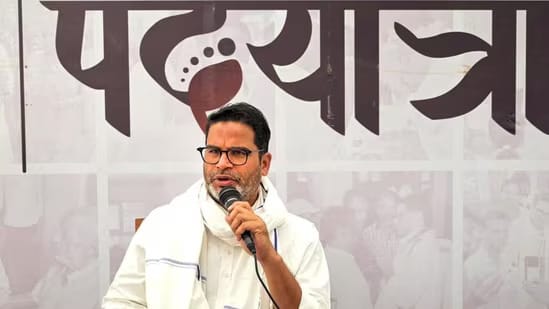
Jan Suraaj’s Challenges and Losses
Organizational Weakness: Jan Suraaj is a new party that has no organizational structure or history. Winning such a large number of seats purely on the charisma of Prashant Kishor is a major challenge.
Label of “Vote Cutter”: Political analysts view Jan Suraaj in the role of a vote cutter. If Jan Suraaj fails to win seats on a large scale, it will only be labelled as a party that cuts the votes of the established parties.
Victim of Political Attacks: The NDA has leveled serious accusations against him, such as the ‘Surat incident’ (claiming that some Jan Suraaj candidates withdrew their nominations under BJP pressure), alleging an attempt to weaken democracy. He has appealed to the Election Commission to ensure the safety of his candidates.
Jan Suraaj’s Impact on the NDA and Mahagathbandhan
Prashant Kishor claims that he will cut the votes of corrupt and old leaders of both major alliances, which will harm both.
| Alliance | Effect | Reason |
| NDA | Moderate impact on Middle Class and Upper Castes | PK’s appeal mainly attracts educated youth, urban, and dissatisfied upper-caste voters, who are considered BJP supporters but are upset due to lack of employment. Highlighting the failure of Nitish Kumar’s good governance also weakens the NDA’s vote base. |
| Mahagathbandhan (INDIA Alliance) | Biggest loss (due to vote cutting) | PK is directly targeting Tejashwi Yadav’s candidature for the Chief Minister’s post by raising the fear of the return of ‘Jungle Raj’ (Lalu-Rabri era) in his speeches. This could affect their traditional Extremely Backward Class (EBC) and non-Yadav OBC votes, which often lean towards the Mahagathbandhan in an anti-incumbency wave. |
Targeting Samrat Chaudhary (BJP):
Prashant Kishor has made direct and sharp personal attacks on the prominent BJP leader and Deputy Chief Minister, Samrat Chaudhary. He has publicly raised issues like Chaudhary’s educational qualification (degree controversy) and old criminal cases (claims of being accused of genocide). PK’s attack is part of a two-pronged strategy:
- To show that the BJP is also protecting tainted leaders, even though it projects itself as a symbol of clean politics, opposite to ‘Jungle Raj’.
- By making such personal and sensational allegations, he creates space in the media and keeps Jan Suraaj at the centre of discussion, allowing his agenda to reach more voters.
In brief, Jan Suraaj is transforming the Bihar election from bipolar to triangular. If Jan Suraaj succeeds in gaining even 5-10% of the vote, it can disrupt the equation of both the NDA and the Mahagathbandhan in many close seats and divide the anti-incumbency votes.
AIMIM’s Attempt to Join the Grand Alliance:
“Akhtarul Iman,” the MLA from Kochadhaman, a former RJD and JD(U) leader, joined the AIMIM in 2015. He was made the party’s state president in Bihar. Under the leadership of Akhtarul Iman, the party contested in the Seemanchal region on a small scale in 2015—contesting 6 seats but did not win.
AIMIM in the 2020 Assembly Election
In the subsequent 2020 Assembly election, the AIMIM made inroads into the Seemanchal region and won 5 seats (Baisi, Amour, Kochadhaman, Bahadurganj, and Jokihat)—this was a significant blow to the Mahagathbandhan. Later, 4 MLAs who won from AIMIM joined the RJD in 2021–22, raising questions about the AIMIM’s ground strength and organizational stability.
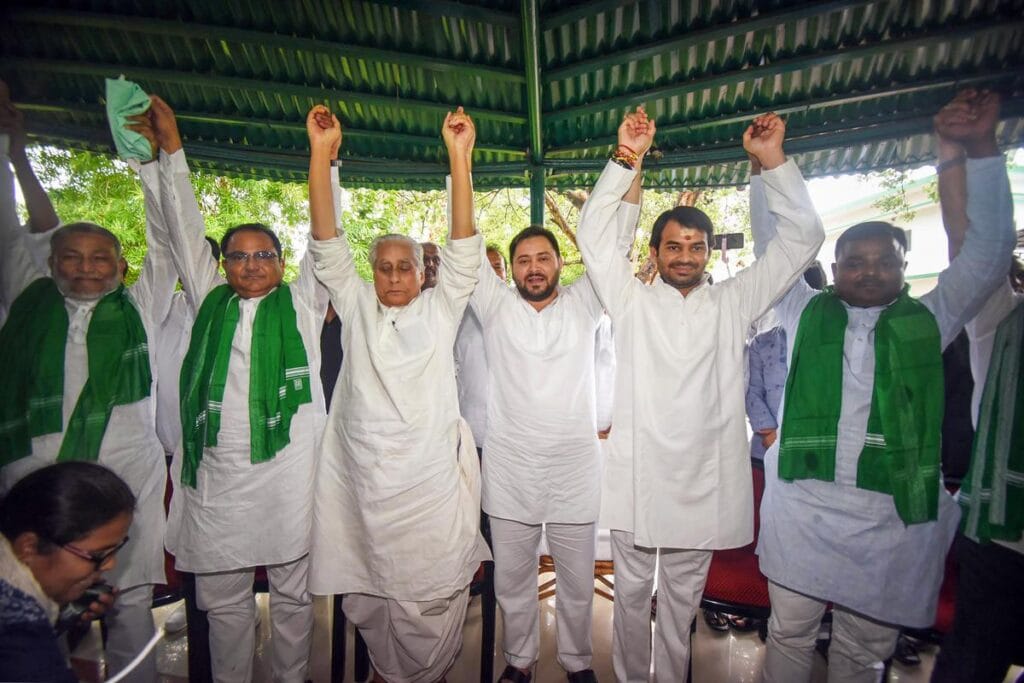
Demand for 6 Seats
After the MLAs left the party, the AIMIM adopted an active and aggressive stance again in Bihar, keeping the 2025 Assembly elections in mind. In the last election, the Grand Alliance cited the AIMIM as one of the reasons for its loss against the NDA, calling it a ‘vote cutter’ and the ‘B-team of the BJP’. To avoid these labels, the AIMIM expressed a desire to join the Mahagathbandhan. However, due to an inadequate response from the Mahagathbandhan and dissatisfaction with the talks, the AIMIM, which demanded 6 seats, tried to pressure the Grand Alliance by claiming it would contest on a large scale (25–100 seats). But the Mahagathbandhan, viewing Muslims merely as its vote bank, adopted an obstinate stance and refused to give them a share. The AIMIM’s potential partnership with the Mahagathbandhan fell through. Experts believe this will certainly impact the election results.
Iman Sahib, in collaboration with Chandrashekhar and Maurya Ji, has also staked a claim in Mithilanchal/Magadh apart from Seemanchal and is fielding non-Muslim leaders like Rana Ranjit Singh, which clearly indicates that the AIMIM is trying to move beyond the basic Muslim-only strategy.
Voter Enrollment and Election Commission
Court Case and Rahul Gandhi’s ‘Exposé’:
Transparency regarding the electoral process and voter list has always been a sensitive issue. Questions have been raised in political circles about the decisions of the Election Commission (EC). Opposition leaders like Rahul Gandhi have allegedly spoken of an ‘expose’ against the Election Commission regarding alleged irregularities in the voter list or manipulation in the nomination process.
Activist Yogendra Yadav:
The well-known political analyst and activist Yogendra Yadav has constantly commented on the impartiality of the electoral process. He monitors the functioning of the Election Commission and often expresses his opinion publicly regarding voter enrollment and electoral reforms.
Allegations of Pressure on Jan Suraaj Candidates:
Jan Suraaj chief Prashant Kishor has openly alleged that three candidates of his party were forced to withdraw their nominations by top BJP leaders, calling it the “murder of democracy.” He has appealed to the Election Commission to ensure the safety of his candidates.
Detailed Analysis of the Two Major Alliances
National Democratic Alliance (NDA):
The NDA appears united in Bihar and has announced its seat-sharing for all 243 seats, with the main focus on the leadership of Prime Minister Narendra Modi.
| Party | Leader | Estimated Contested Seats |
| Bharatiya Janata Party (BJP) | Samrat Chaudhary | 101 |
| Janata Dal (United) (JD(U)) | Nitish Kumar | 101 |
| Lok Janshakti Party (Ram Vilas) (LJP(RV)) | Chirag Paswan | 29 |
| Hindustani Awam Morcha (Secular) (HAM(S)) | Jitan Ram Manjhi | 6 |
| Rashtriya Lok Morcha (RLM) | Upendra Kushwaha | 6 |
| Total | – | 243 |
Internal skepticism remains over Nitish Kumar’s CM face, as the BJP leadership has not openly declared him the next CM candidate. This uncertainty could create tension within the alliance.
Mahagathbandhan or INDIA Bloc:
The Mahagathbandhan has ended its leadership uncertainty by officially declaring Tejashwi Yadav as the Chief Ministerial face. Mukesh Sahani has been declared the Deputy Chief Minister face. However, the delay in finalizing seat-sharing has created some confusion.
| Party | Leader | Key Role |
| Rashtriya Janata Dal (RJD) | Tejashwi Yadav | Chief Ministerial Face |
| Indian National Congress (INC) | Rajesh Kumar | Major Ally |
| Communist Party of India (Marxist-Leninist) Liberation (CPI-ML) | Mahboob Alam/Dipankar Bhattacharya | Strong Left Party |
| Communist Party of India (CPI) | Ram Naresh Pandey | Allied Left Party |
| Communist Party of India (Marxist) (CPM) | Ajay Kumar | Allied Left Party |
| Vikassheel Insaan Party (VIP) | Mukesh Sahani | Deputy Chief Ministerial Face |
| Indian Inclusive Party | Er. IP Gupta | Potential Ally |
| Independent | – | Supporting the Alliance |
Complexities remain over the final distribution of seats among RJD, Congress, and the Left parties, which caused a delay in the nomination for the first phase. Accommodating VIP and other smaller parties is also a challenge.
Third Front: Grand Democratic Alliance and Others
The Third Front can reduce the margin of victory or defeat on many seats, primarily causing a significant loss to the Mahagathbandhan in many seats. The main party of the Third Front is Owaisi Sahib’s AIMIM, whose core vote is Muslim, which the Mahagathbandhan considers its vote bank. According to some reports, this Third Front is planning to contest a total of 64 seats, with AIMIM taking 35 seats, Azad Samaj Party ~25, and Swami Prasad Maurya’s party ~4 seats:
All India Majlis-e-Ittehadul Muslimeen (AIMIM):
Asaduddin Owaisi’s party, the All India Majlis-e-Ittehadul Muslimeen (AIMIM), made a strong effort to join the Mahagathbandhan before the election and allegedly demanded 6 seats. However, after their demand was ignored by the Mahagathbandhan, the AIMIM formed a Third Front and released its first list of 25 candidates, focusing on the Muslim-dominated Seemanchal region (Kishanganj, Araria, Purnia).
This move by the AIMIM could affect the electoral equation by cutting the votes of the Mahagathbandhan (especially RJD) on Muslim-majority seats. The total population of Muslims in Bihar is 17.7%.
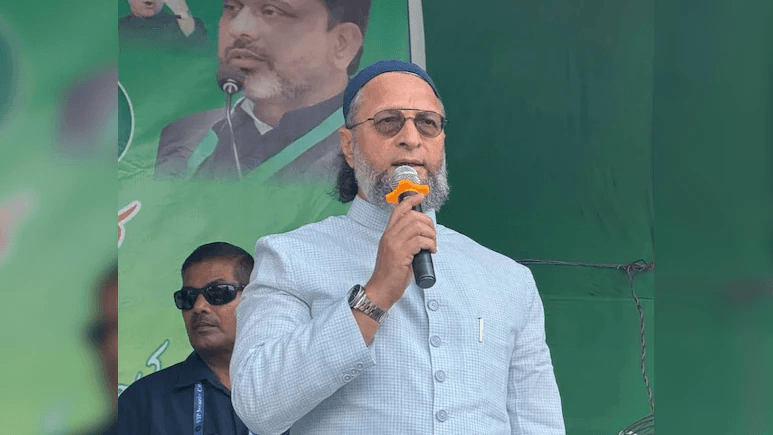
Rashtriya Lok Janshakti Party (RLJP):
The Rashtriya Lok Janshakti Party (RLJP) was founded by Pashupati Kumar Paras in 2021 when the Lok Janshakti Party (LJP) split between the Chirag Paswan and Paras factions. The RLJP is the breakaway faction of Ram Vilas Paswan’s original LJP, which remained aligned with the NDA (BJP alliance). Paras was made a Union Minister, which gave the party recognition and strength at the Centre. The RLJP’s base in Bihar is primarily within the Dalit (Paswan) community, especially in the Jamui, Khagaria, Hajipur, and Samastipur regions. In the 2024 Lok Sabha election, the RLJP contested as part of the NDA alliance, claiming to continue the legacy of the Paswan family.
Azad Samaj Party (Kanshi Ram) (ASP):
The Azad Samaj Party (Kanshi Ram) was founded by Chandrashekhar Azad, the head of the Bhim Army, in 2020, to give political representation to Dalits, Backward Classes, and the underprivileged. The party is named in honour of Kanshi Ram, the father of the Bahujan movement. Initially, the party was active in Uttar Pradesh politics and contested a limited number of seats in some assembly elections. Jauhar Azad is the State President of the Bihar Azad Samaj Party (Kanshi Ram).
In recent years in Bihar, the ASP has tried to make inroads into the Seemanchal and Dalit-dominated regions by forming an alliance with AIMIM and other parties. The party’s main goal is to establish a “New Bahujan Movement” based on social justice, education, and equal political rights.
Apni Janata Party (AJPA):
Swami Prasad Maurya Ji’s “Apni Janata Party” has emerged as a component of the Third Front in the 2025 Bihar Assembly election. The AJPA, active in Uttar Pradesh politics, does not have an extensive history available in Bihar. In the Third Front, this party is contesting 4 Assembly seats. The total population of the Maurya community in Bihar is… (Information incomplete in original text).
Caste-Based Seat Distribution and Equations
Caste equations have remained the main axis of the Bihar elections:
- NDA’s Base: The NDA primarily relies on a combination of Upper Castes (Brahmin, Rajput, Bhumihar, Kayastha) and a large section of the Extremely Backward Class (EBC) and Mahadalits, along with Kurmi/Koeri votes (Nitish Kumar).
- Mahagathbandhan’s Base: The Mahagathbandhan relies mainly on the M-Y (Muslim-Yadav) equation, which is the traditional base of the RJD. Additionally, an attempt is being made to attract Dalits, landless farmers, and a section of the EBC through the Left parties and CPI(ML). With the arrival of Mukesh Sahani (VIP), the Mallaha (boatmen) community’s vote may shift towards the Mahagathbandhan.
- Third Front’s Impact: Parties like AIMIM and Jan Suraaj will weaken the traditional vote banks of both major alliances by cutting votes.
Jan Suraaj Party (Prashant Kishor)
JSP aims to become a strong alternative political force in Bihar. The party is contesting all 243 seats, led by Prashant Kishor, although he is not contesting the election himself. His challenge is to break the traditional caste-based politics and focus on the issues of good governance and development.
Bahujan Samaj Party (BSP)
Leader: Shankar Mahto (Bihar). This party, led by Mayawati, holds influence over a section of the Dalit votes in Bihar. Although its influence is limited, it can harm both the NDA and the Mahagathbandhan on some reserved seats.
Aam Aadmi Party (AAP)
Leader: Rakesh Yadav (Bihar). AAP has marked its presence in Bihar. However, its penetration in the state’s traditional caste politics is still limited. The party can attract some votes in urban areas on the issues of anti-corruption, education, and health.
Janshakti Janata Dal (Tej Pratap Yadav)
Leader: Tej Pratap Yadav. The party/front of Tej Pratap Yadav, the elder son of RJD supremo Lalu Yadav, may contest some seats. Although his influence may be limited, his intervention could expose the dissatisfaction within the RJD and divide votes in the family strongholds.
Election Date
The Election Commission of India has declared the following dates for the Bihar Assembly Election:
- Phase 1: November 6, 2025 (121 seats)
- Phase 2: November 11, 2025 (122 seats)
- Counting and Result Date: November 14, 2025
Conclusion
The Bihar Assembly Election 2025 is a complex and multi-cornered contest. The NDA has taken the lead by finalizing its seat-sharing plan, but the uncertainty over Nitish Kumar’s leadership role is an internal challenge for it. The Mahagathbandhan, on the other hand, has sent a message of unity by declaring Tejashwi Yadav as the CM face, but the delay in seat-sharing and the division of votes by parties like AIMIM could make its path difficult. Prashant Kishor’s ‘Jan Suraaj’ has emerged as a significant disruptive force, which could make the final result unpredictable.
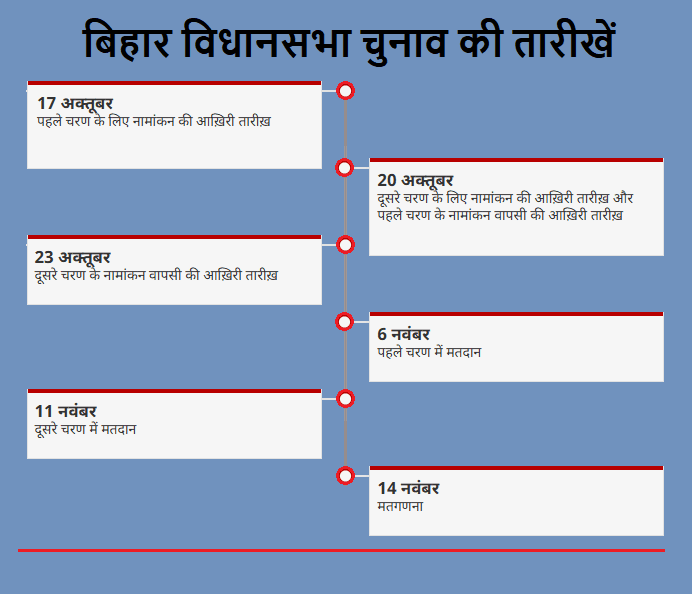
Figures of the Last Bihar Election 2020
The Bihar Assembly Elections 2020 were significant for Indian politics in many respects. The election was primarily fought between the two major alliances — the National Democratic Alliance (NDA) and the Grand Alliance (MGB) — with both throwing their full might to gain power.
1. Detailed Analysis of the Two Grand Alliances
A. National Democratic Alliance (NDA)
The NDA contested the election under the leadership of the incumbent Chief Minister, Nitish Kumar (JD(U)).
- Included Parties (Mainly):
- Bharatiya Janata Party (BJP)
- Hindustani Awam Morcha (Secular) (HAM(S))
- Vikassheel Insaan Party (VIP)
Seat Sharing: JD(U) and BJP contested on an approximately equal number of seats. The NDA secured a majority by winning a total of 125 seats.
Result: The balance of power within the NDA shifted in favour of the BJP in this election. The BJP won 74 seats, while the JD(U) was restricted to only 43 seats. HAM(S) and VIP secured 4 seats each. The poor performance of the JD(U), which made it the ‘junior partner’ in the alliance, was a major political change.
B. Mahagathbandhan (MGB) (2020 Context):
The Mahagathbandhan declared Rashtriya Janata Dal (RJD) leader Tejashwi Yadav as its Chief Ministerial face.
- Included Parties: Rashtriya Janata Dal (RJD), Indian National Congress (INC), Communist Party of India (Marxist-Leninist) Liberation (CPI-ML), Communist Party of India (CPI), Communist Party of India (Marxist) (CPM).
- Seat Sharing: RJD contested the most seats with 144. INC was given 70 seats. The Left parties (CPI-ML, CPI, CPM) were given a total of 29 seats.
- Result: The Mahagathbandhan won a total of 110 seats. RJD emerged as the single largest party with 75 seats. INC won only 19 seats, and its poor strike rate was considered a major reason for the alliance falling short of a majority. The Left parties performed brilliantly, winning 16 seats (CPI-ML won 12) and strengthening the alliance.
Caste-Based Seat Distribution and Equations (2020 Context):
Bihar elections have always been based on caste equations. Both alliances paid special attention to caste arithmetic in ticket distribution:
| Alliance | Vote Bank | Ticket Distribution Trend (2020) |
| NDA | EBC, Mahadalit, Upper Castes | BJP mainly focused on Upper Castes and OBCs (especially non-Yadavs). JD(U) gave more tickets to OBC/EBC (Kurmi, Kushwaha) and Mahadalit communities to court its traditional vote bank. |
| Mahagathbandhan | M-Y (Muslim-Yadav), Left-Supporters | RJD focused on strengthening its core M-Y (Muslim-Yadav) equation. RJD gave a large number of tickets to Yadav and Muslim candidates. Congress tried to court Upper Castes (Brahmin, Rajput, Bhumihar) and some OBC/EBCs. The Left parties utilized their base among Dalits, Extremely Backward Classes, and the poor. |
Conclusion (2020 Context): The NDA won with a combination of Nitish Kumar’s EBC-Mahadalit-Women base and the BJP’s Upper Caste-Non-Yadav OBC base. The Mahagathbandhan strengthened the M-Y equation, but despite the poor performance of the Congress and the vote cutting by the Third Front (LJP led by Chirag Paswan) against the JD(U), they fell short of a majority.
Third Alliance: AIMIM, JAP, and Others (2020 Context):
A Third Front also emerged in the Bihar elections 2020, which had a significant impact on the results.
A. Grand Democratic Secular Front (GDSF): This alliance was formed with parties like AIMIM (All India Majlis-e-Ittehadul Muslimeen) and RLSP (Rashtriya Lok Samata Party, Upendra Kushwaha).
- AIMIM (Asaduddin Owaisi): AIMIM contested in the Seemanchal region (where the Muslim population is high) and surprised everyone by winning 5 seats.
- Jan Adhikar Party (JAP) – Pappu Yadav: JAP, led by Pappu Yadav, marked its presence in the election but did not achieve major success. However, its presence on some seats also affected the vote equation of the main candidates.
- Jan Suraaj (Prashant Kishor) (Special Reference): In the 2020 election, Prashant Kishor (PK) was not directly involved as a political party, but he later launched the ‘Jan Suraaj’ campaign. Prashant Kishor’s ‘Jan Suraaj’ campaign was launched as a foot march separate from a political party, aiming to create an alternative political platform in Bihar. This campaign is contesting the election directly, but its main objective is to bring about change in politics at the grassroots level. It had no direct impact on the 2020 elections, but its role as an option for clean and non-casteist politics could be important in future elections.
Conclusion of Bihar Election 2020: The NDA retained power in the Bihar elections 2020, but the BJP emerged as the bigger force in the alliance. The Mahagathbandhan put up a tough fight, but it missed the majority due to the poor performance of the Congress and the AIMIM’s encroachment into Muslim votes. This election reflects the increasing acceptance of youth leadership (Tejashwi Yadav) in Bihar and the growing relevance of issues like ‘development’ and ’employment’ alongside caste-based equations.

